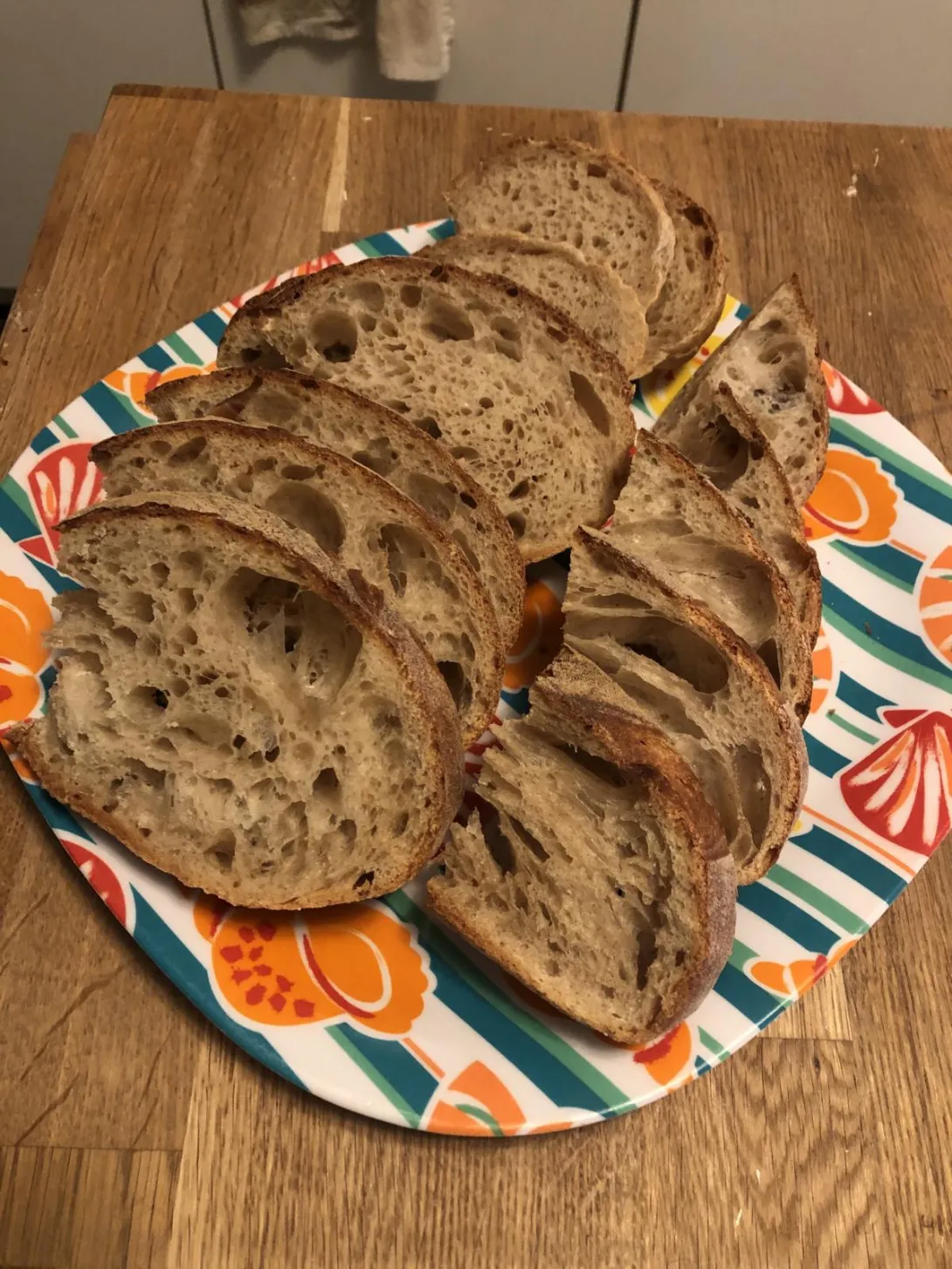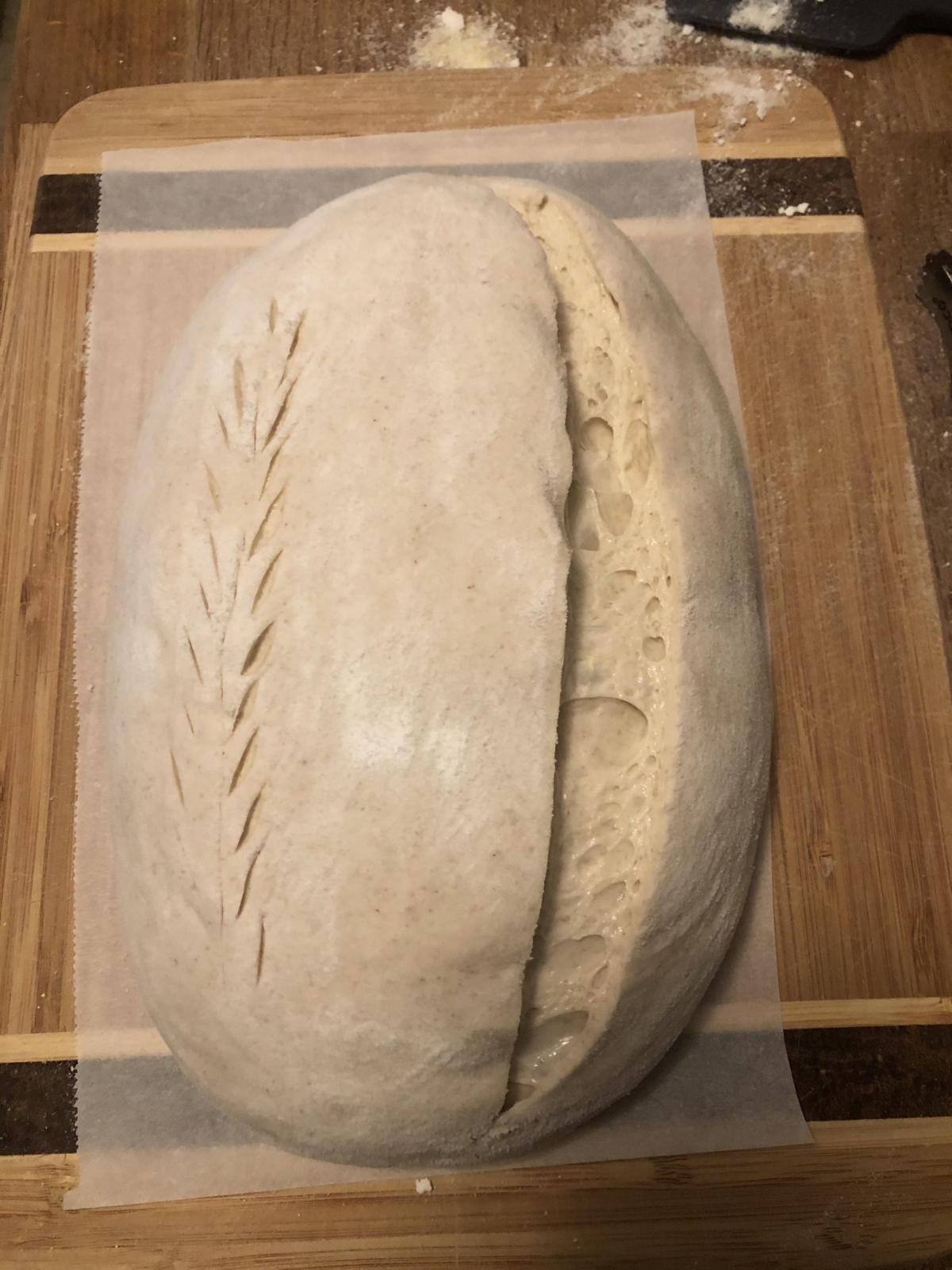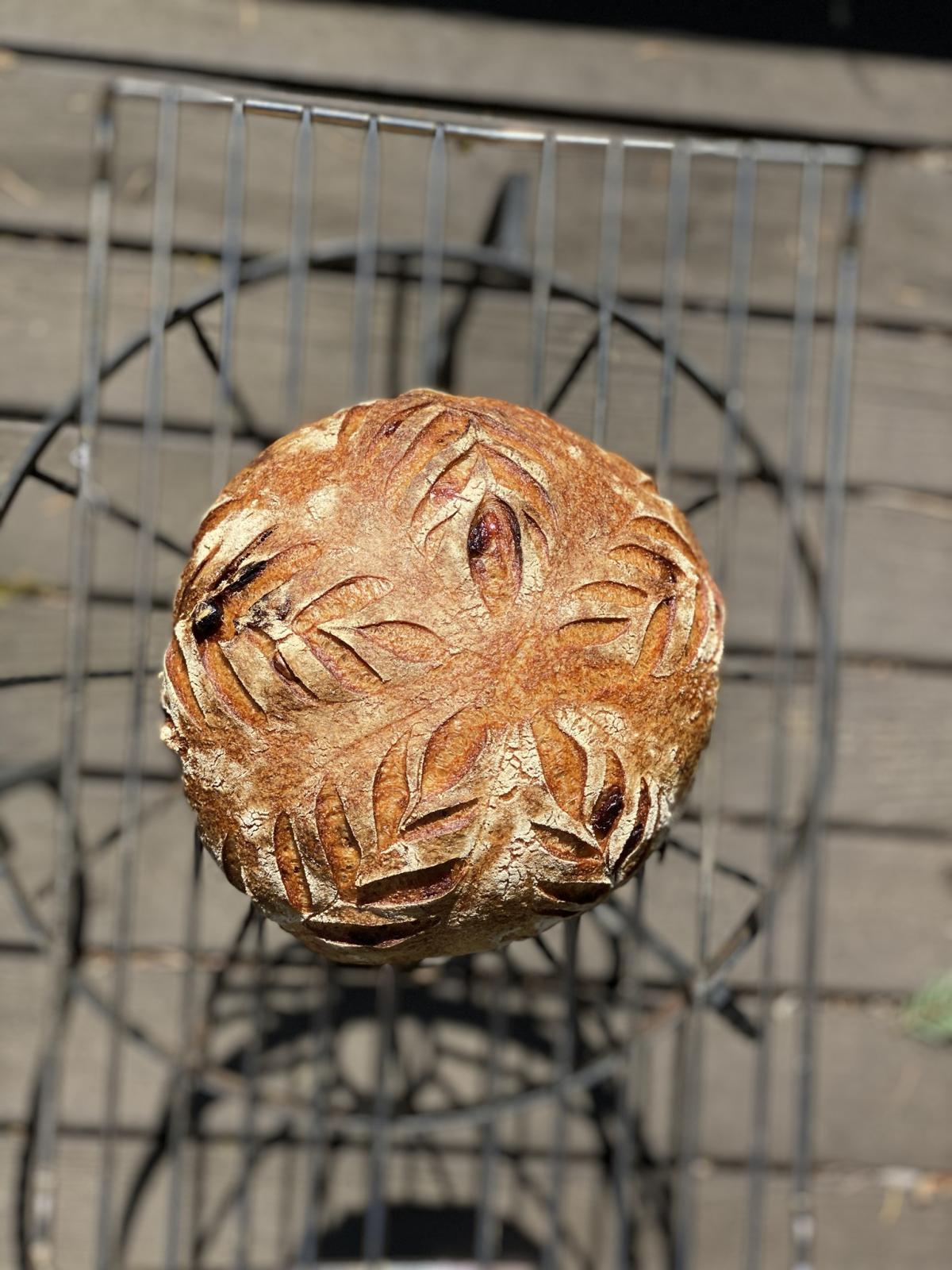
Hi all, this is my first post! I've been lurking on this site for a long long time and have greatly benefited from your community's brain trust. In these wild pandemic times, I've been maximizing my home kitchen output and supplies to make bread for poor individuals and families in my local area (Detroit). I was recently donated a 50 lb bag of KA Sir Lancelot flour from a (sourdough) pizza place that's closed temporarily to help with my efforts of making nutritious sourdough bread for those in need. It's very generous, but I understand the high gluten content of KASL is better meant for pizza and bagels rather than hearth breads. My normal go-to recipe for an open crumb white loaf would be something like 90% AP/10% whole wheat. I have a good amount of King Arthur's blue bag bread flour I want to use up too (~40 lbs) along with some AP I'm hoping to mix with the KASL to use it up and give a less dense crumb. Here's my plan for a recipe I concocted while out walking my dog, would like to know people's thoughts:
45% AP
30% KA bread flour
15% KA Sir Lancelot
10% whole wheat
78% H20
Does that seem like an ok recipe to use up the KASL? I'll also be using it to maintain my starter and build leavens (along with some rye I have stashed away). Would love to hear people's thoughts. Attached is a pic of the crumb I'm shooting for, this is from a bake last weekend using 90% KA bread flour (blue bag) and 10% whole wheat. Hope you're all staying sane and healthy during these messed up times.
Hi Mike - Welcome aboard!
Hilariously, I haven't been on here for years, but I just had a baking thread come up in my homebrewers' club list, which I'd also ignored for years - so I recommended Fresh Loaf to all of them. I'm stuck at home now, so baking more and posting long-winded comments. So I'm honored to be the first to reply to you.
I'd say your formula is pretty spot-on there.
If by AP you mean KA AP, then yes. That's a very consistent, strong flour, great for baking. But if you're using an off-brand AP, then all bets are off, it could be most anything, and probably not great.
KA AP is what this former baker would classify as a "straight" flour if I were to compare it to bakery products. It makes a pretty good hearth loaf by itself, chewy but tends to be dense, and may get sticky at high hydration.
KA Bread is what we'd call a "patent" flour, which we'd use for classic American white bread loaf, or dinner rolls or sweet dough with some shortening. It has a good amount of gluten, and tends to be light-bodied and extensible.
I've never actually used KA Sir Lance, but my experience is that high-gluten flours can vary in properties as well; some are more like super-patent - very stretchy and light, others are tougher, and more "bucky" - that is, they resist stretching, snap back into shape, and will tear if you over-tighten your loaf. But a little bit of buckiness is a good thing if you like a lot of grigne and big ears.
For my usual loaves, lately I've been using Shepherd's Grain since I can get it in bulk bags at a good price (aka Stone-Buhr in 5 lb supermarket bags): 60% AP, 30% Hi-G, and 10% whole wheat, sifted to remove the bran.
Obligatory bread porn pic: trying out my new bannetons :-)
Love it, beautiful bake! Thanks for the advice and comments. My AP supplies are kind of a mish-mash right now of some KA, some Great River Milling organic, some Delallo unbleached. I assume they're all around the 11% protein range. Out of curiosity, why do you sift your whole wheat to remove the bran? I've read something about how bran can act like little daggers to the gluten but I don't really get what that means!
-Mike
Hi Mike -
Yes, I think both the oil and bran in whole wheat flour can reduce some of the gluten development potential, but that said, I use 100% WW from KA, Stone-Buhr, or Gold Medal, with 1 oz butter/margarine per loaf, and they are plenty stretchy. And I've used up to 50% WW in unshortened hearth loaves with great results...better pop than some white flours.
I got the sifting idea to mimic Golden Buffalo flour, or a high-extraction custom-milled flour like Maggie Glezer talks about. It just gives you more color and wheaty nuttiness from the germ while still looking like a "refined" flour w/o big flecks. Pretty much cosmetic, and then I put the extra bran in my morning cereal, or in the whole wheat loaves, or use it instead of cornmeal for bread board and peel dusting.
What kind and how much WW do you have? If you have access to "white whole wheat" (home milled, Trader Joe, Kroger, or King Arthur) you might be able to "hide" a higher proportion of WW in the loaf.
And what kind and how much AP flour do you have?
i'm sure your recipients are very grateful, but sourdough style boules are likely outside the "zone of familiarity" for many.
One of the grand lessons of the "approachable loaf", http://www.thefreshloaf.com/node/62486/community-bake-approachable-loaf-bread-lab
is ... that the pan-style, sandwich style allows people to be better able to stay in their "comfort zone." I think the majority of every-day caucasian-Americans and African-Americans think of a sandwich loaf when they think of bread, and would consider artisan-style holes to be defects. Or, maybe I'm misjudging your intended recipients. What has been the feedback so far?
I would also consider mixing the 4 flours in the same proportion that you have them on hand. If you had equal amounts of all 4, then mix 1:1:1:1., or 25%, 25%, 25%, 25%. Assuming you are making small batches for a home oven, you can experiment small.
Another idea: tangzhong to soften the bread. That might be a good counter to the KASL hi-protein flour. Plenty of instructions on TFL on how to do that.
Good luck, and God bless. Sounds like a noble cause.
I don't have a ton of whole wheat, about 20 lbs to be exact. I'm including it for a little extra nutrition and to give the leaven a little extra love. I wouldn't mind using more in the future but I kind of want to get through the supplies I have now, then figure out where to go from here! You make a really good point on accessibility and I think generally the people I'm supplying these loaves to are not really people that would line up at an artisan bakery for a country loaf. However, part of what I'm doing is to provide them with something nice and special because they are special. I've never baked using tangzhong but that is a really interesting idea. Thanks!
-Mike
Hmmm - if by less dense you mean less chewy - all you really have to do is lessen the amount of gluten that gets developed. More time = more gluten formation, less time = less gluten formation. Seems counter intuitive to limit the amount of gluten we create - but sounds like that's what you're looking for.
My "normal" flour is just shy of 17% protein (pretty high), and I use it for everything from pizza dough to biscuits. Pizza I like a chewy crust so it gets left overnight (or 2) for lots of gluten. Biscuits on the other hand, the dough gets mixed with minimal handling (one of the secrets to a good biscuit) and used within minutes thereby keeping gluten formation too a minimum (a chewy biscuit just isn't right).
Only thing you might notice is - the higher the protein content - the more water may be needed (but at your hydration level you won't notice much difference).
Good luck and stay safe (been hearing Detroit was getting hit hard right now) - Enjoy!
It's so sad what's happening here but to be honest it's not surprising. This covid crisis is a magnifying glass for existing social problems that have plagued Detroit forever - concentrated poverty, poor health outcomes, water access, tax foreclosures, etc. On the brightside, it is incredible how much joy I can bring people with a simple loaf of home made bread! I'm just going to keep plugging away until I run out of supplies. Good point on the handling. I keep an eye on the gluten development as I'm going along and maybe cut out one set of coil folds!
-Mike
I would think more in terms of time - like the time from first mixing the dough to the time it goes into the oven. I don't stretch and fold or anything like that save for something like a minute or 2 of the traditional hand kneading when the dough is first mixed just to ensure everything it well incorporated. Then I just let time do its thing, which is to form gluten - or not form gluten by not allowing it the time to form. I find something around 4 hrs gives a soft textured (think store bought white bread) texture. The longer you go the heavier and more chewy the texture gets. Of course flavor changes as fermentation time also changes. Balancing the 2 (texture and flavor) is a trick, or art in itself.
Good luck, and as always - Enjoy!
That's an excellent point! I made a batch yesterday using a slightly modified version of the formula I posted (40%AP, 30% KA bread, 20% KA SL, 10% ww) and baked them this morning. I definitely noticed that the gluten had sufficiently formed much earlier in the dough development than with my usual mostly AP loaves. I cut back to single coil fold about halfway through bulk (4 hours at 80F) and I think that may have even been unnecessary! I'm pretty happy with the bake overall (see below). I usually get a little bit more oven spring but these are still nice. I'm giving them all away so no crumb shot for now, but I will ask for an interior shot once they're cut into :) I'm developing another batch tomorrow and I think I'll just leave it be like you suggest after getting everything incorporated and see how that goes!
About the only reason I can see for handling a dough after mixing is really to redistribute the yeast and bacteria so it has a fresh food source (they aren't to mobile). As far as gluten goes, it's actually hard to get flour and water to not form gluten. That's what wheat flour does when water is added (2 proteins, glutenin and gliaden - I think that's the spelling - latch onto molecules of water and join to form our friend gluten). Ask you have to do is give it time to form to the level you desire - hence no knead bread. Which is how I do all my breads. Also makes it a lot easier to work bread making into a schedule - mix it up the night before - throw it in the oven next day. No muss no fuss easy peasy. After 8-12 hrs at the golf course (my true addiction) I'm in no mood, or shape, to baby sit a loaf of bread for any length of time. And I refuse to buy stale shabby tasting bread from the store (I'm in a small town in the sticks of Vermont and no real bakery in a like a 50+ mile radius).
As always - Enjoy!
Hey, can you please share how you scored the beautiful wheat pattern on your loaves? I just love that! Thanks!
Sure! they're really just quick little slashes in succession to form that pattern. The key is you need to slash kind of aggressively and consistently to get it to open up just right. Here's a couple pre and post bake photos from a couple of weeks ago. The pattern is a little different but it's the same basic idea. Happy baking!
Very beautiful!
Thanks for helping me not be so intimidated by such scoring! Here’s what I got!
Thanks so much! I took Jedediah (my starter) out of the fridge and plan to bake tomorrow. Will try that fancy scoring.